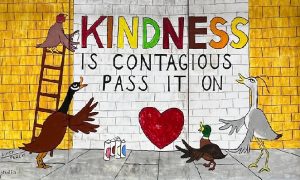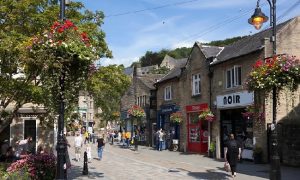04-11-2024
LONDON: Home to just 4,500 people and set in a scenic, rural valley, this quaint market town has blossomed into a bastion of tolerance.
“None of the bars here are gay bars,” said Liz Paton but “at the same time, they all are.”
 Paton is the charismatic owner of Drink, an independent taproom in the Yorkshire market town of Hebden Bridge, where my boyfriend and I were visiting for a long weekend.
Paton is the charismatic owner of Drink, an independent taproom in the Yorkshire market town of Hebden Bridge, where my boyfriend and I were visiting for a long weekend.
Nestled between Manchester and Leeds in the scenic Upper Calder Valley, for years this rural town which calls itself a “bohemian paradise”, thanks to its many eco-friendly shops, artisan markets, galleries and indie bookstores had been on my wish list. And so on my recent birthday, we finally booked a trip to stroll its cobbled streets, explore its rivers and canals, climb the surrounding wooded hillsides and of course gaze down from its eponymous 16th-Century packhorse bridge.
Though only boasting a population of roughly 4,500 people, this small, peaceful community has long been known as “the lesbian capital of the UK” 8.95% identified as LGBTQ+ in the last Census. I was curious to trace the queer history of “Trouser Town” (a nickname referencing Hebden Bridge’s manufacturing heritage) but as I soon discovered, its evolution from a rural mill town to a tolerant bastion was a bit blurry.
Back in the 1970s, artists and activists were drawn here by cheap housing after the cotton mills shut down. “One historical and cultural factor (that helped establish a burgeoning lesbian community) may have been the separatist wing of 1960s and 1970s feminism,” said Dr Andrew Moor, who teaches film studies at Manchester Metropolitan University. “There was an element which allied itself with alternative hippy culture’s experiments in alternative living, communes and a resistance to full-throttle capitalism. Hebden was the right size and in the right place.”
Former resident Bev Manders moved here in the 1980s. “Certainly up to 1986, lesbians weren’t particularly visible as far as I can ascertain,” she said but so steady was the growth of the community that, in neighbouring  Todmorden, a monthly Women’s Disco was launched. “The first took place on New Year’s Eve 1986 at Cornholme Church Hall,” said Manders. “With a fair amount of women there, it’s my belief that this is the point we became more visible, and it also gave others the impetus to be visible and some to come out.”
Todmorden, a monthly Women’s Disco was launched. “The first took place on New Year’s Eve 1986 at Cornholme Church Hall,” said Manders. “With a fair amount of women there, it’s my belief that this is the point we became more visible, and it also gave others the impetus to be visible and some to come out.”
The disco was held in various venues before relocating to Todmorden Cricket Club, where it still takes place on the second Saturday of the month. “Within a short time, word got out and there’d be women coming from Bradford, Leeds, Burnley and even Cumbria, Blackpool and Nottingham.”
From 1986 to the early 1990s, Manders recalls that “an influx of lesbians” descended on the small town. “A number moved to the valley as they knew someone who lived there or had previously visited. Others had heard through the grapevine about this ‘new’ place with lesbians. In addition to the disco, there were writers’ groups, book clubs, a choir and walking groups. Some were exclusively lesbian, some women-only.”
By the late 1990s a monthly pamphlet, Lesbian Zone, was available to buy via subscription or at specific bars and by 2004 Hebden had the highest number of lesbians per capita in the UK.
Bar owner Paton was born and raised in Calderdale but drawn to Hebden from a young age. “I was aware of the ‘lesbian hippy’ moniker,” she said. “It was about seeking refuge amongst more open-minded people; artists and new-wave travellers made for happy bedfellows during the 1970s and ’80s.” (Int’l News Desk)
 Pressmediaofindia
Pressmediaofindia




